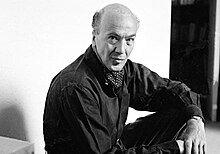Luis Barragán
Mexican architect (1902-1988)
Luis Barragán (Guadalajara, March 9, 1902 - Mexico City, November 22, 1988) is considered the most important Mexican architect of the 20th century. He created an architectural style that combined modernism with the colonial and prehispanic architecture of Mexico. In 1980, he became the second winner of the Pritzker Prize. His house and studio, built in 1948 in Mexico City, was listed as a UNESCO World Heritage site in 2004.


| This article about an architect is a stub. You can help out with Wikiquote by expanding it! |
Quotes
edit- Any work of architecture which does not express serenity is a mistake.
- Contemporary Architects, St. Martins Press.
- I believe that architects should design gardens to be used, as much as the houses they build, to develop a sense of beauty and the taste and inclination toward the fine arts and other spiritual values.
- Contemporary Architects, St. Martins Press.
In his acceptance of the Pritzker Architecture Prize, 1980
edit- It is impossible to understand Art and the glory of its history without avowing religious spirituality and the mythical roots that lead us to the very reason of being of the artistic phenomenon. Without the one or the other there would be no Egyptian pyramids, nor those of ancient Mexico. Would the Greek temples and Gothic cathedrals have existed?
- Beauty, Inspiration, Magic, Spellbound, Enchantment, as well as the concepts of Serenity, Silence, Intimacy and Amazement. [...] They have never ceased to be my guiding lights.
- The Art of Seeing. It is essential to an architect to know how to see: I mean, to see in such a way that the vision is not overpowered by rational analysis.